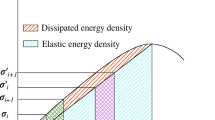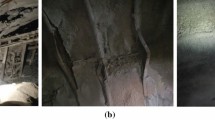Abstract
To study the anisotropic mechanical properties and energy evolution of layered rock masses under the action of cyclic loading, uniaxial graded cyclic loading and unloading tests under different upper and lower stress limits were carried out on samples with different bedding angles (0°, 22.5°, 45°, 67.5°, and 90°) to explore the deformation and mechanical response characteristics of bedded phyllite under cyclic loading and the mechanism controlling the evolution of the total absorption energy, elastic strain energy, and dissipated energy. The damage variable D and the damage increment ΔD were introduced to characterize the damage accumulation state inside the layered rock mass, and an instability criterion of bedded phyllite under mechanical cyclic loading was proposed. The results show that when the bedding angle increases from 0° to 90°, the failure types of the sample change from splitting shear failure to slip** shear failure and then to splitting tensile failure, and the corresponding irreversible strain and deformation modulus first decrease and then increase. With increasing stress level, the cumulative energy density increases in three stages, and the rate of increase presents a change in characteristic of "accelerating-steady-decelerating." The energy storage coefficient (Ke) decreases with increasing cycle number and stress level and first increases and then decreases with increasing bedding angle. Meanwhile, the energy dissipation coefficient (Kd) exhibits the opposite trend. The damage increment increases ΔD sharply after the first cycle in the nonfailure stage, drops sharply in the next cycle, and gradually decreases and stabilizes to near ΔD = 0.01 in the subsequent cycle. After entering the failure stage, the change in the damage increment of the variation in phyllite samples with different bedding angles is closely related to the stress level and number of cycles. The damage variable D can be used to describe the failure and instability of bedded phyllite under graded cyclic loading: when D ≤ 2 × 10–4, the rock is in the stage of compaction and steady crack growth; when D ≥ 2 × 10–4, the rock is at risk of failure and instability.
Highlights
-
The changes in the irreversible strain and elastic modulus were analyzed based on the results of uniaxial graded cyclic loading and unloading testing.
-
The evolution and distribution rules of various energy indicators under uniaxial graded cycle load are discussed from the perspective of energy.
-
An instability judgment index based on energy dissipation theory is proposed, considering the relationship of layered millennium rock macro–micro deformation and energy evolution under the cyclic load.



















Similar content being viewed by others
Data availability
The data that support the findings of this study are available from the first and corresponding authors on reasonable request.
Abbreviations
- σ m :
-
Uniaxial compressive strength
- Δε :
-
Axial strain
- E 1 :
-
Deformation modulus in the loading stage
- E 2 :
-
Deformation modulus in the unloading stage
- σ :
-
Upper and lower limit stress difference of cyclic loading and unloading
- ε p :
-
Plastic strain
- ε e :
-
Elastic strain
- U :
-
Total energy absorbed by the rock from the outside
- U e :
-
Elastic strain energy produced by the reversible deformation of the rock
- U d :
-
Dissipation energy produced by the irreversible deformation of the rock
- K e :
-
Energy storage coefficient
- K d :
-
Energy dissipation coefficient
- ΔD :
-
Damage increment
- D :
-
Damage variable
- σ u :
-
Upper limit load value of each stress level
- S L :
-
Variance of the damage increment of each stress level
References
Arora K, Chakraborty T, Rao KS (2019) Experimental study on stiffness degradation of rock under uniaxial cyclic sinusoidal compression loading. Rock Mech Rock Eng 52:4785–4797. https://doi.org/10.1007/s00603-019-01835-3
Bagde MN, Petroš V (2005) Waveform effect on fatigue properties of intact sandstone in uniaxial cyclical loading. Rock Mech Rock Eng 38:169–196. https://doi.org/10.1007/s00603-005-0045-8
Bao H, Pei RS, Lan HX, Yan CG, Xu JB, Zhai Y, Xu XH (2021) Damage evolution of Biotite quartz schist caused by mineral directional arrangement under cyclic loading and unloading. Chin J Rock Mech Eng 40(10):2015–2026
Fu HL, Zhang JB, Huang Z, Shi Y, Chen W (2018) A statistical model for predicting the triaxial compressive strength of transversely isotropic rocks subjected to freeze–thaw cycling. Cold Reg Sci Technol 145:237–248. https://doi.org/10.1016/j.coldregions.2017.11.003
Fu B, Hu LH, Tang CA (2020) Experimental and numerical investigations on crack development and mechanical behavior of marble under uniaxial cyclic loading compression. Int J Rock Mech Min. https://doi.org/10.1016/j.ijrmms.2020.104289
Fuenkajorn K, Phueakphum D (2010) Effects of cyclic loading on mechanical properties of Maha Sarakham salt. Eng Geol 112:43–52. https://doi.org/10.1016/j.enggeo.2010.01.002
Gao YH, Feng XT (2019) Study on damage evolution of intact and jointed marble subjected to cyclic true triaxial loading. Eng Fract Mech 215:224–234. https://doi.org/10.1016/j.engfracmech.2019.05.011
Gong FQ, Yan JY, Li XB, Luo S (2019) A peak-strength strain energy storage index for rock burst proneness of rock materials. Int J Rock Mech Min 117:76–89. https://doi.org/10.1016/j.ijrmms.2019.03.020
Hao XJ, Wang SH, Xu QS, Yang DQ, Zhang Q, ** DX, Wei YN (2020) Influences of confining pressure and bedding angles on the deformation, fracture and mechanical characteristics of slate. Constr Build Mater. https://doi.org/10.1016/j.conbuildmat.2020.118255
Li TT, Pei XJ, Wang DP, Huang RQ, Tang H (2019) Nonlinear behavior and damage model for fractured rock under cyclic loading based on energy dissipation principle. Eng Fract Mech 206:330–341. https://doi.org/10.1016/j.engfracmech.2018.12.010
Li CB, Gao C, **e HP, Li N (2020) Experimental investigation of anisotropic fatigue characteristics of shale under uniaxial cyclic loading. Int J Rock Mech Min 130:104314. https://doi.org/10.1016/j.ijrmms.2020.104314
Liu Y, Dai F (2018) A damage constitutive model for intermittent jointed rocks under cyclic uniaxial compression. Int J Rock Mech Min 103:289–301. https://doi.org/10.1016/j.ijrmms.2018.01.046
Liu Y, Dai F, Dong L, Xu NW, Feng P (2018) Experimental investigation on the fatigue mechanical properties of intermittently jointed rock models under cyclic uniaxial compression with different loading parameters. Rock Mech Rock Eng 51(1):47–68. https://doi.org/10.1007/s00603-017-1327-7
Liu YB, Yin GZ, Li MH, Zhang DM, Deng BZ, Liu C, Lu J (2019) Anisotropic Mechanical Properties and the Permeability Evolution of Cubic Coal Under True Triaxial Stress Paths. Rock Mech Rock Eng 52:2505–2521. https://doi.org/10.1007/s00603-019-01748-1
Liu HX, Gao KF, Zhu X (2020) Experimental study on dynamic fatigue properties of dolomite samples under triaxial multilevel cyclic loading. B Eng Geol Environ 80:551–565. https://doi.org/10.1007/s10064-020-01954-0
Meng QB, Liu JF, Li R, Pu H, Chen YL (2020) Experimental study on rock strength and deformation characteristics under triaxial cyclic loading and unloading conditions. Rock Mech Rock Eng 54:777–797. https://doi.org/10.1007/s00603-020-02289-8
Momeni A, Karakus M, Khanlari GR, Heidari M (2015) Effects of cyclic loading on the mechanical properties of a granite. Int J Rock Mech Min 77:89–96. https://doi.org/10.1016/j.ijrmms.2015.03.029
Peng RD, Ju YJ, Wang JG, **e HP, Gao F, Mao LT (2015) Energy dissipation and release during coal failure under conventional triaxial compression. Rock Mech Rock Eng 48(2):509–526. https://doi.org/10.1007/s00603-014-0602-0
Peng K, Shi SQ, Zou QL, Wen ZJ, Wang YQ, Jiang ZB, Zheng CS (2021) Quantitative characteristics of energy evolution of gas-bearing coal under cyclic loading and its action mechanisms on coal and gas qutburst. Rock Mech Rock Eng 54:3115–3133. https://doi.org/10.1007/s00603-021-02446-7
Si XF, Gong FQ (2020) Strength-weakening effect and shear-tension failure mode transformation mechanism of rockburst for fine-grained granite under triaxial unloading compression. Int J Rock Mech Min 131:104347. https://doi.org/10.1016/j.ijrmms.2020.104347
Vaneghi RG, Thoeni K, Dyskin AV, Sharifzadeh M, Sarmadivaleh M (2020) Strength and damage response of sandstone and granodiorite under different loading conditions of multistage uniaxial cyclic compression. Int J Geomech 20(9):04020159
Wang Y, Tan WH, Liu DQ, Hou ZQ, Li CH (2019) On anisotropic fracture evolution and energy mechanism during marble failure under uniaxial deformation. Rock Mech Rock Eng 52:3567–3583. https://doi.org/10.1007/s00603-019-01829-1
Wang Y, Zhao LX, Han DH, Qin X, Ren JL, Wei QQ (2020) Micro-mechanical analysis of the effects of stress cycles on the dynamic and static mechanical properties of sandstone. Int J Rock Mech Min 134:104431. https://doi.org/10.1016/j.ijrmms.2020.104431
Wang Y, Feng WK, Hu RL, Li CH (2021) Fracture evolution and energy characteristics during marble failure under triaxial fatigue cyclic and confining pressure unloading (FC-CPU) conditions. Rock Mech Rock Eng 54:799–818. https://doi.org/10.1007/s00603-020-02299-6
**ang ZP, Wang HL, Xu WY, **e WC (2020) Experimental study on hydro-mechanical behaviour of anisotropic columnar jointed rock-Like specimens. Rock Mech Rock Eng 53:5781–5794. https://doi.org/10.1007/s00603-020-02245-6
Zhang QB, Zhao J (2014) A review of dynamic experimental techniques and mechanical behaviour of rock materials. Rock Mech Rock Eng 47(4):1411–1478. https://doi.org/10.1007/s00603-013-0463-y
Zhang JB, Fu HL, Huang Z, Wu YM, Chen W, Shi Y (2019) Experimental study on the tensile strength and failure characteristics of transversely isotropic rocks after freeze–thaw cycles. Cold Reg Sci Technol 163:68–77. https://doi.org/10.1016/j.coldregions.2019.04.006
Zhao Y, Bi J, Wang CL, Liu PF (2021) Effect of unloading rate on the mechanical behavior and fracture characteristics of sandstones under complex triaxial stress conditions. Rock Mech Rock Eng 54:4851–4866. https://doi.org/10.1007/s00603-021-02515-x
Zhao K, Ma HL, Liang XP, Li XX, Liu YB, Cai R, Ye LL, Yang CH (2022) Damage evaluation of rock salt under multilevel cyclic loading with constant stress intervals using AE monitoring and CT scanning. J Petrol Sci Eng 208:109517. https://doi.org/10.1016/j.petrol.2021.109517
Zhu XY, Chen XD, Dai F (2020) Mechanical properties and acoustic emission characteristics of the bedrock of a hydropower station under cyclic triaxial loading. Rock Mech Rock Eng 53:5203–5221. https://doi.org/10.1007/s00603-020-02218-9
Acknowledgements
This study was financially supported by the National Natural Science Foundation of China (Grant No. 52108367) and the Science and Technology Department of Guangxi Zhuang Autonomous (Grant No. AD21238018). The authors also express special thanks to the editors and anonymous reviewers for their constructive comments.
Author information
Authors and Affiliations
Corresponding author
Ethics declarations
Conflict of interest
The authors declare that they have no known competing financial interests or personal relationships that could have appeared to influence the work reported in this paper.
Additional information
Publisher's Note
Springer Nature remains neutral with regard to jurisdictional claims in published maps and institutional affiliations.
Rights and permissions
Springer Nature or its licensor (e.g. a society or other partner) holds exclusive rights to this article under a publishing agreement with the author(s) or other rightsholder(s); author self-archiving of the accepted manuscript version of this article is solely governed by the terms of such publishing agreement and applicable law.
About this article
Cite this article
Zhang, J., Du, R., Chen, Y. et al. Experimental Investigation of the Mechanical Properties and Energy Evolution of Layered Phyllite Under Uniaxial Multilevel Cyclic Loading. Rock Mech Rock Eng 56, 4153–4168 (2023). https://doi.org/10.1007/s00603-023-03279-2
Received:
Accepted:
Published:
Issue Date:
DOI: https://doi.org/10.1007/s00603-023-03279-2




